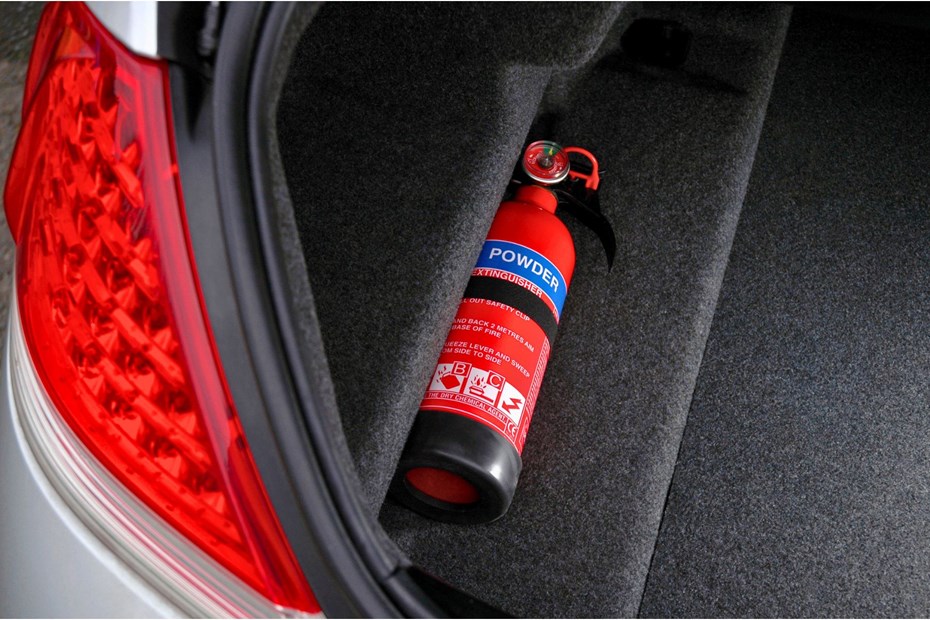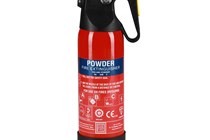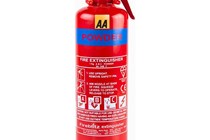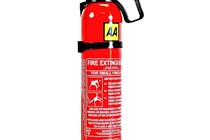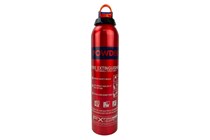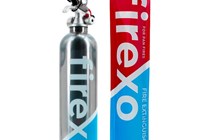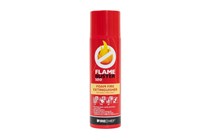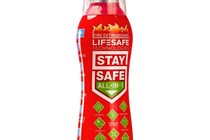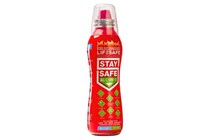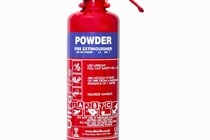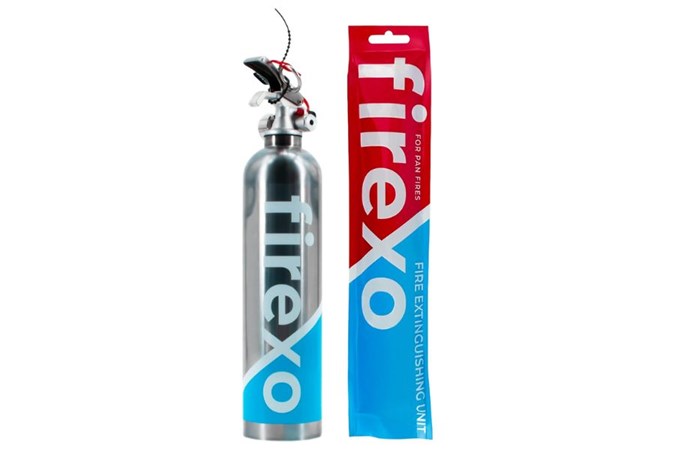Car fire extinguishers are vital for providing a level of safety to you and your passengers in the unwanted situation of a car fire. According to Fire Service around 35,000 car fires happen accidentally every year in the UK, so it’s important to make sure you’re prepared should the unexpected happen. In some countries, like Poland, it is a legal requirement to carry a fire extinguisher on board your vehicle.
Car fires can occur for one of several reasons; sometimes it can be from a fuel system leak, or faulty electrical wiring, or even after a collision. During these situations it is important to remain calm and prioritise the safety of all occupants of the car. The first thing you’ll want to do is get everyone out of the car to a safe distance. If the fire is small enough then you can try to put it out yourself, but if you have any doubts then call the emergency fire service and don’t leave it to chance.
Just like other items – like torches – carrying a fire extinguisher is always a good idea. There are several safe, effective, and easy-to-use solutions that are ideal for storing in the car.
There are a few types of fire extinguishers suitable for cars: Among them powder or foam extinguishers are recommended because they are effective in extinguishing B class fires. Those are usually flammable liquid fires, like petrol or diesel. Fire extinguishers are categorised into six classifications based on their ability to extinguish different types of fires. These classifications range from A, B, C, D, F, and Electrical and show if the fire extinguisher is effective against solid combustibles, flammable liquids, flammable gases, flammable metals, combustible cooking media, and electrical appliances respectively.
The best car fire extinguishers 2025 at a glance
Generally, any fire extinguisher that is labelled ABC should be good enough to carry in the car in case of emergencies. You should also make sure that your fire extinguisher has been manufactured in accordance with BS (EN) 3 – a set of safety standards for portable fire extinguishers. These extinguishers will have a BAFE, LPCB, or BSI approval label on them.
The best car fire extinguishers 2025
Best car fire extinguisher
In addition to the fire extinguisher, you also get the Pan fire sachet which is a great alternative for safely putting out pan fires in the kitchen. That makes it ideal for motorhomes that include a kitchen. There’s even a mounting bracket included so you can attach the fire extinguisher to a wall inside your motorhome.
Pros
- Approved for all types of fires from A-F and lithium-ion batteries
- Ideal for use in the home, car, and camping
- Compact at 38cm long, which makes it very portable
Cons
- Slightly heavier than others at 1.6kg
- Less value for money than others
| Fire types | A, B, C, D, Electrical, F, lithium-ion batteries |
| Capacity | 500ml |
| Extinguisher type | Biodegradable natural ingredients |
| Weight | 1.6kg |
Editor's pick
The StaySafe All-in-1 has been fully tested and approved by the BSI (British Standard Institute) and is safe to use on multiple types of fires. While there isn’t much guidance on the fire classifications that the StaySafe All-in-1 covers, it is specified for use on electrical, cooking oil, textiles, petrol/diesel, paper/card, motor oil, and bio-ethanol fire types. In addition to this it is fine to use on Lithium-ion batteries like you would find in phones and laptops.
Pros
- Compact, useful bottle that can be kept anywhere
- Can tackle a range of fire types from electrical to engine-based
- Capable of extinguishing lithium-ion batteries
Cons
- Instructions should be a bit clearer in terms of fire classifications
- Other extinguishers have better range
| Fire types | A, B, Electrical, F |
| Capacity | 200ml |
| Extinguisher type | Wet chemical |
| Weight | 200g |
Best for safest fire extinguisher
The AA1547 comes with a safety clip that can prevent accidental use but is easy to operate in the case of an emergency. The 600g can discharge in just 6 seconds, while the 950g allows 9 seconds of use. The discharge length is two to three meters. If you’re looking for a safe and reliable fire extinguisher, then the AA1547 is suitable for your needs.
Pros
- Comes in three sizes
- Comes with a safety clip to avoid misuse
- Two to three meters discharge length means the user can stay far from the fire
Cons
- Only 6 seconds of use in the 600g version
- Slightly more expensive than others
| Fire types | A, B, C, Electrical |
| Capacity | 1kg |
| Extinguisher type | Dry Powder |
| Weight | 2kg |
Best for vehicles
The UltraFire is supplied with a bracket designed for storage inside a vehicle, so it is ideal to keep you and your occupants safe in the event of a car fire.
Pros
- Suitable for Class A, B, and C fires
- Lightweight, which makes it portable and easy to keep within your vehicle
- Easy to use, thanks to simple squeeze handle
Cons
- Class D-F fires not covered, which limits its capabilities
- Not suitable for use indoors
| Fire types | A, B, C |
| Capacity | 1kg |
| Extinguisher type | Dry powder |
| Weight | 1.3kg |
Best for easiest to use
The highlight of the FireChief Flamebuster 500 All-in-1 is its lightweight and easy-of-use, which makes it suitable for people of all abilities. Simply aim the extinguisher and squeeze the top like an ordinary spray.
Pros
- Lightweight and easy to store, available in two sizes.
- Easy-to-use
- Can tackle A, B and F classification fire including electrical fires
Cons
- Can be mistaken for another spray
- Slightly less value for money than others
| Fire types | A, B, C |
| Capacity | 1kg |
| Extinguisher type | ABC Powder |
| Weight | 2.3kg |
FAQs and things to remember about fire extinguishers for cars
-
What are all of the fire categories?
Categories of fire are put into six classes and are as follows:
Class A: Fires that involve solid materials, i.e. wood, paper, and textiles.
Class B: Fire that involves liquids, i.e. petrol, diesel, oil, greases, and solvents. This doesn't include cooking oil.
Class C: Fires that involve gas, i.e. natural gases, liquid petroleum gas (LPG).
Class D: Fires involving metals, i.e. magnesium, sodium or potassium.
Formerly known as Class E: these are fires involving live electrics.
Class F: Fires involving cooking oils and fats. -
Why are KGs labelled differently in fire extinguishers?
You'll find different KG ratings because they represent different things. Manufacturers will often use ton unit of KG to label how much foam and/or other product is within the extinguisher itself - akin to a capacity rating. The other KG rating is how heavy the extinguisher is in total when you add the bottle and components up.
-
If I'm carrying a fire extinguisher in a car, where should I place it?
Anywhere that's easy to access. If a car is on fire, the last thing you want is to spend ages trying to reach for an extinguisher while flames and deadly smoke are quickly building up. The easier it is to reach, the better, as you can get yourself somewhere safe more quickly. Something like a tyre inflator can be stored away further, as a puncture is less hazardous.
You will find in many performance cars, such as fast Porsches and Ferraris, a little fire extinguisher placed in the passenger footwell. This ensures ease of access should a fire occur. It also echoes what racing versions of those cars have, ensuring that either the driver or track marshal can easily access it. -
Does a car fire extinguisher have an expiry date?
Yes, it is important to regularly check and maintain your fire extinguisher so that you’re always prepared. Most fire extinguishers have a three-year expiry date but we recommend checking yours annually. Always read the safety information and follow the product guidance.
-
What kind of fire extinguisher should I look for?
Fire extinguishers come in various types, but the ones that are most suitable for automotive use are powder-based extinguishers that are suitable for electrical fires. You’ll often see A, B and C classifications which specify the types of fires that the extinguisher is suitable for. If you can find one that covers A, B and C then that’s ideal but at the very least B and C classification should be suitable.
Naveed Hussain is a commercial content writer at Bauer Media writing for Parkers and CAR. He enjoys anything with four wheels, and is always planning his next road trip.
Sign up to the Parkers Newsletter to keep up to date with more of the latest reviews, news, and recommendations from the Parkers team.
Just so you know, while we may receive a commission or other compensation from the links on this page, we never allow this to influence product selections – read why you should trust us
Just so you know, we may receive a commission or other compensation from the links on this website - read why you should trust us.


